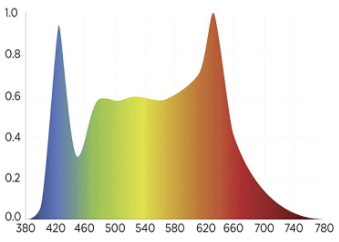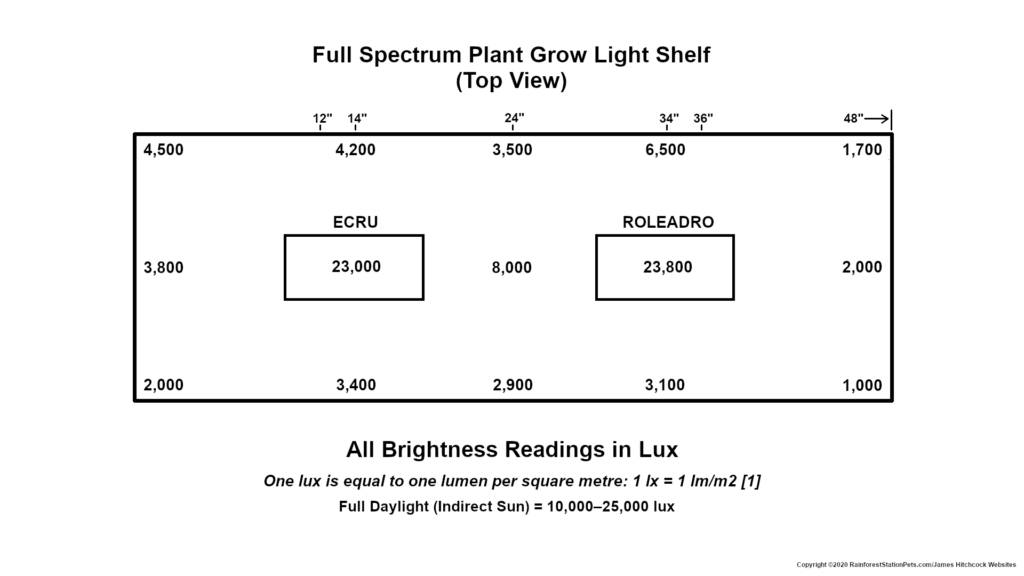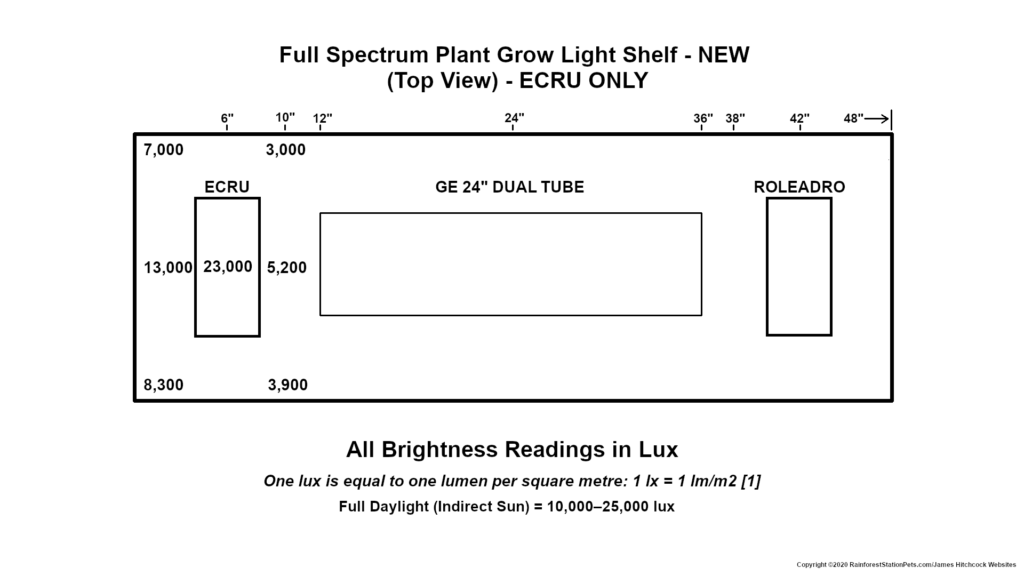Our Plant Grow Light Shootout includes the ECRU Full-Spectrum Plant Grow Light
snapshot
ECRU BH043121 LED plant grow light
| MANUFACTURER: | ECRU |
| MODEL: | BH043121 |
| PRICE: | $29.99[2] |
| COUPON: | LIGHTNING DEAL + 10% coupon |
| STYLE: | RECTANGULAR PANEL |
| RANK: | 91[2] |
| REVIEWS: | 4.4[2] |
| ASIN[2]: | B07SGL2DLM |
| QUANTITY: | 1 |
| SPECTRUM: | FULL |
| LEDS (TOTAL): | 50 |
| LEDS (BY COLOR): | 8 R, 2 B, 24 WARM W, 16 COLD W |
| LEDS (NM RANGE): | 380-780, 4000K |
| POWER EQUIV: | 150 W |
| POWER (WATTS): | 28.5[4] |
| PPFD (μmol/m2/s): | 300 AT 12” |
| SIZE: | 8.3X4.3X1.2 |
| MAX COVERAGE: | 2X2 FEET AT 12” HEIGHT |
| WATERPROOF: | IP65 DAMP-PROOF |
| ON/OFF SWITCH | Y |
| FAN | N |
| DAISY CHAIN | N |
| MATERIAL | METAL FRAME, PLASTIC LENS |
| WARRANTY/RETURN | NOT NOTED/30 DAY |
| LED LIFE (HOURS): | NOT LISTED |
Affiliate links to products in this article:
Reed Instruments R8140 LED light meter:
ecru Full-Spectrum LED Plant Grow Light:
On Amazon
On eBay (similar items, same item unavailable on eBay)
ECRU Store on Amazon
Super Sprouter products:
on Amazon
on eBay
(you pay nothing extra by clicking these links, but we may get a commission if you purchase a product)
The ECRU entry in our full-spectrum LED plant grow light comparison is model number, BH043121, or you can reference it with its ASIN[3]: B07SGL2DLM (affiliate link). Priced at $25.99[2], it offered a 10% off coupon, and was on a Lightning Deal when we purchased it. It was 91 on Amazon’s best-seller list for LED plant grow lights, but had a 4.4 overall review rating, so the two metrics somewhat evened out the decision. The Lighting Deal was what really pulled the trigger on this one.
This full-spectrum plant grow light has only 50 LEDs, with an interesting selection of eight red, two blue, 24 warm white, and 16 cold white. The product listing reports that this group of LEDs produces the equivalent of a 150 watt incandescent. These LEDs are reported to produce a PPFD[5] of 300 μmol/m2/s at a height of 12 inches.
Current draw wasn’t listed on Amazon, but in our measurements, the lamp draws an average of 28.5 watts of electricity. The LED lifespan is not reported, nor is the warranty, but it offers the standard 30 day return period.
Along with the low price and interesting LED diode configuration, this ECRU plant grow light really sold us with its metal construction that is “damp proof,” but not totally waterproof – the housings of most plant grow lamps in this price range are made of plastic. The listing claims the metal is stainless steel, and a magnet verifies the frame is not ferrous steel, but the black oxide coating makes it hard to verify. Its tiny rectangular 9 inch by 5 inch size also intrigued us. Its maximum coverage area of two feet square seems a bit generous, for verification see the test below with our Reed 8140 LED light meter.

Looking at the spectral analysis graph provided by ECRU (Figure 1), you can see that there is much more light produced between the blue and red spikes compared to the Red/Blue lights in our LED Plant Grow Light Comparison. Proponents of this “Full-Spectrum” light say this green light penetrates the canopy better, to reach lower leaves on the plant. Reported Photosynthetic Photon Flux Density (PPFD)[5] is 300 μmol/m2/s at 12 inches. This is about the same our runner-up FECiDa red/blue plant grow light is reported to produce at 8 inches, and a bit less than what the Shengsite Red/Blue panel is reported to produce at 8 inches – using 250 LEDs compared to 50 in this plant grow light.

Based on the description of the light we had planned to use it to illuminate half of a 18” x 48” shelf in our LED Plant Light Comparison. However, when we unboxed the light, its size, even considering the high-output LED diodes, gave us pause about this expectation. And, after mounting it lengthwise 14 inches from the end of the 48-inch shelf, our light measurements bore out our suspicions. With the light mounted about 12 inches above our soil height, the light dropped precipitously just a few inches from the center of the lamp. In Figure 2 you can see the readings in lux[5] on the left side of the shelf where the ECRU lamp is mounted – and these readings are with the Roleadro LED plant grow light on the left side turned on. Ignoring PPFD for the moment, full daylight with indirect sun measures between 10,000 and 25,000 lux[5]. The reading directly under the ECRU Full-Spectrum plant grow light was comfortably in that range at 23,000. However, just nine inches away from the center point at the front edge of the shelf the reading was just 3,400 lux. Light-loving plants such as the carnivorous and succulent plants we were using would not be happy outside a small area under the lamp.
So, realizing we were too optimistic, we redesigned the Full-Spectrum shelf in our plant grow light comparison. We added a General Electric 24” LED plant grow light, and turned the ECRU and Roleadro Full-Spectrum plant grow lights perpendicular to the shelf and mounted it about 6 inches from the end of the shelf. This placed the light dead center over one of our 10 x 20 inch Super Sprouter trays that contained our carnivorous plants.

In this setting (Figure 3), with the ECRU about 12” above soil height, we measured light directly under the lamp (surrounded on three sides by reflective mylar and now with the GE 24-inch LED plant grow light next to it) at 33,800 lux. Turning off the GE plant grow light we still had our original 23,000 lux directly under the lamp. Measuring six inches left of the fixture at the edge of the shelf produced readings of 13,000 LUX; 4.5 inches behind the fixture, with the benefit of the reflective mylar, we received a reading of 16,000 lux, however 4.5 inches in front of the fixture – at the front of the shelving unit, without the benefit of the mylar – we measured 10,000 lux. Light in the corners still dropped precipitously, but will be better with all three lights on.
Similar to the Roleadro full-spectrum plant light, the ECRU setup seemed a perfect match to the 10×20 inch Super Sprouter trays we are using. And, if you watch the price of these lamps, sometimes they dip and offer coupons bringing them down to about half the price of the T8-style LED lamps of which we are using three on our control shelf. At that price, you could buy four – one to cover each 10×20 Super Sprouter tray that will fit on the shelf – and spend less in purchase cost than three T8-style LED shop lights that run about $25 at the local hardware store. And, four of the ECRU LED plant grow lights will consume about 120 watts of electricity, about the same as the T8-style LED shop lights that each draw 40 watts, but will produce far more intensive light.
[1] https://en.wikipedia.org/wiki/Lux
[2] Price and other data accessed 09/14/2020 and subject to change
[3] Amazon Standard Identification Number
[4] Tested in our setup
[5]Photosynthetic Photon Flux Density – a measurement of light reaching the surface
[6] https://en.wikipedia.org/wiki/Lux